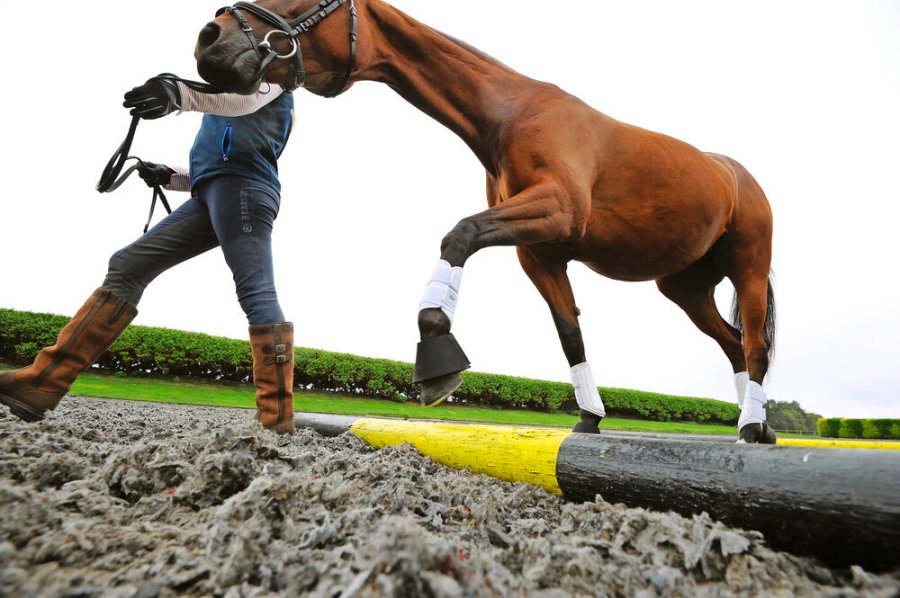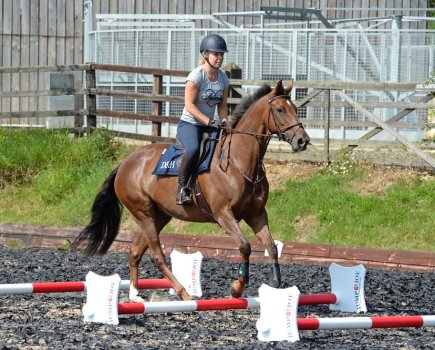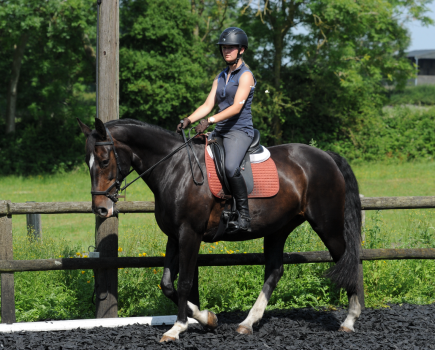Groundwork exercises for horses in the form of in-hand polework is pilates for equines and just five minutes a day can make a difference (although between 15 and 20 minutes is ideal) — and it can be a useful way of training alongside lunging a horse. The more developed your horse’s core, balance, suppleness, engagement and focus, the better they’ll be able to do their job, whatever it is, and it will help them stay healthy and sound too
The following groundwork exercises for horses challenge all of these key areas in their body. Even the simplest of groundwork exercises will have an effect on a horse (and on you, too) and it pays to incorporate in-hand polework into your weekly routine. It’s particularly useful during the winter, when riding time can be limited and for those who aren’t confident riding over poles, in-hand work has the same benefits so there’s no reason for you or your horse to miss out.
Getting started with groundwork exercises for horses
You only need a maximum of four poles for the exercises explained here and if you’re not great at working out distances between poles, there’s no need to worry — it doesn’t matter for these. There are a few things to consider when starting out with in-hand polework:
- Always use a bridle with reins so you can direct your horse more easily.
- Wear a riding hat, sturdy boots and gloves for your own safety.
- The ideal place to be when leading your horse is alongside their head and on their outside, so that your horse turns away from you at a corner.
- Don’t influence your horse at all. Let them work things out for themselves. Get them to the poles, then leave them to it.
- Only do these groundwork exercises for horses in walk.
- Make sure each exercise is done on both reins and repeat each one two or three times before moving on.
- Don’t rush your horse through the exercises — they need time to think.
- Carry a schooling whip to ensure they don’t drop behind you.
- Give yourself and your horse plenty of room on the turn into the poles.
- 10ft poles are the best size to use — and the heavier the better.
- If the horse taps or rolls a pole, leave it and keep going — distances don’t matter here.
Warming up for groundwork
You may think that because you’re not riding your horse, you don’t need to worry about a warm-up session — but this is incorrect. It doesn’t need to be long or very testing, but both you and your horse need to be ready to tackle these polework exercises. Think of it as an easing-off session, untying all the knots and stiffness. You need to check your horse is walking with purpose before you begin, too.
Walk a couple of laps around the arena on both reins. This will give you time to assess your horse’s mood. Are they fresh? Are they lazy? Try not to influence them too much — when doing in hand work like this, your horse needs to be allowed to make mistakes so they can learn from them.
Four groundwork exercises for horses
1 The simple square
Expect a positive walk, quality of stride and straightness from your horse. Focus your attention outside the square, looking where you’re going, not down at the poles.
How to do it:
Arrange four poles in a square shape with the poles touching end to end (so each side is 10ft long). Then do the following:
- Aiming for the centre of the poles (if yours have a band of colour around the middle, this will make it easier), walk straight through the square. Walk with purpose and expect your horse to come along with you, not lag behind or rush ahead. Think about raising your legs as you step over the poles and not just tripping over them — it’s a great core strengthening movement for riders.
- Now mix the exercise up by walking through the square diagonally, which means as you enter and exit you’ll be going over the join of two poles. Because of the join, your horse (and you) will take a bigger step in and out — again, good for the core. Focus on staying straight — your entry and exit points are much narrower now, so it would be easy to wobble off line.
- Going diagonally again over the joins, halt your horse in the middle of the square. Slow down and use your body language to stop them, not the reins. Stand for a few seconds, then move smartly away and out. Aim for a square halt each time, but don’t faff with your horse once they’re standing still. Just keep practising — the halt will improve each time you go through.
- In this last exercise using the square, you’ll go across the short diagonal, cutting close to the corner. This shortens the stride — which is good for engagement — and lifts your horse’s barrel and back up too, creating suppleness. It also encourages your horse to think about where they’re putting their feet — essential if they’re going to do any jumping.
2 Time for a fan
You’ll need three poles for this groundwork exercise, set out in a fan shape. Don’t worry about distances and, again, using coloured poles will help you stay on track, but they’re not essential. Working on a fan is very effective at creating suppleness as your horse will be stretching their ribcage to the outside and contracting to the inside. It mimics the riding action of them bending around your inside leg.
How to do it:
- Walk your horse through the fan, aiming them at the centre of each pole. Whichever rein you’re on, position yourself on the side that will put you at the narrower end of the fan, which is a challenge in itself.
- Don’t put an extra stride in between poles. Adjust your position to help you balance instead — good for strengthening your core.
- Your horse will be on a curve as they go through the fan. Make sure you don’t try to push their body straight — that’s the easier but incorrect option.
3 A V-shape
For the third and final of my groundwork exercises for horses, place one pole on the floor, with two others resting on it in an upside-down V shape. Don’t put the raised ends too close together to start with. Your horse will need to step higher because of the raised poles — great for engagement. If you’re coming to this exercise straight from the fan (exercise 2), where the horse was on a circle, this exercise will really straighten them up.
How to do it:
- Walk your horse into the V shape and aim for the gap between the two raised poles. As your horse goes through the gap, you step over to the outside of the poles. It sounds simple, but you’ll be surprised how tricky it can be to get your horse to go straight.
- If your horse knocks the poles with their feet or wavers off the line, don’t worry, just come round again.
- To make this exercise a bit more difficult, move the raised end of the poles a little closer together. Your horse will need to concentrate to stay straight and also pick their feet up even higher.









